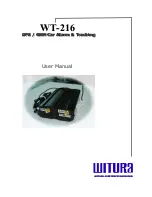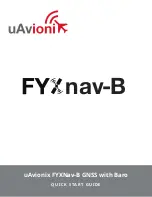
Watson Industries, Inc.
DMS-SGP01 Rev B 03/22/2018
8
The baud rate may be changed from the nominal value of 9600 baud by modifying the default
value in the EEPROM of the unit to 38.4K, 19.2K, or 4800 baud. Please note that the Baud Rate
must be 9600 when using the GPS module.
A text header is sent by the DMS during initializations that identifies the unit by part number and
by serial number and gives the date of last calibration. This whole message can be temporarily (or
as a default) suppressed or restored by a “*” command from the interfacing computer.
Data transmission sent by the DMS can also be suppressed or restored by a “+” command from the
interfacing computer. This is used when only analog data is used as a noise reduction measure.
The error over-range condition is indicated by the use of a lower case “i”, “g” or “r” when the
calculated attitude or heading error exceeds the ranges listed above. Internal functions that require
these error values are disabled while the condition exists. The system will continue to operate in an
extended time constant mode with a low level of error accumulation until the condition is cleared.
While maneuvering the vehicle, occasional blips of this condition are expected with no detectable
effect on the resulting data.
The other output format available is a binary format. In this mode, the unit provides generally the
same information as the decimal ASCII format, but in a compact binary message. In this format,
there are nominally 13 words sent that represent 6 fourteen-bit output channels followed by a
carriage return. Again, the channels may be reduced to improve the update rate by using special
commands to modify the EEPROM of the unit. This format is for highly experienced users only.
Consult the factory for further details.
RS-232 Input Commands
The RS-232 input commands are provided for the purpose of unit test and installation set-up. Use
the same parameters that are used for the RS-232 output (9600 baud ASCII nominal, or as reset in
the units EEPROM).
Note: Many commands require command or “Double spacebar mode” in order to access them. For
more information on how to activate Command Mode, see the instructions in the second part of
Appendix A.
These commands are available to the user (others are used at the factory for alignment and
calibration).
1.
An “R” or “r” will set the outputs (analog and serial) to their Reference Command modes,
replacing the Inertial mode. This will also disable the logic input Reference Command and
Free Mode Command until the next time the unit is powered up. This mode is used in
installation to physically align the unit. Double spacebar at initialization is required for
access to this command.
2.
An “I” or “i” sets the unit to Inertial mode. Switching to this mode clears the Reference
Command mode. This will also disable the logic input Reference Command and Free
Mode Command until the next time the unit is powered up. Double spacebar at
initialization is required for access to this command.








































